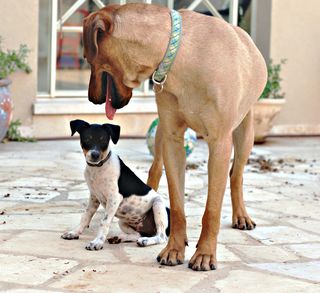Intelligence
Are Big Dogs Smarter Than Small Dogs?
If big dogs have bigger brains, could it give them an intellectual advantage?
Posted January 17, 2019
Size matters. Human beings are larger than more than 90% of the other species living on our planet, and evolutionary anthropologists have argued that our relatively large size has given us a survival advantage. Obviously, our increased size brings with it increased strength. It also means larger organs, including everything associated with the nervous system, so is it possible that larger size also brings with it increased mental ability? And if so, would this fact have implications for relative intelligence in a species like dogs, where breeds may vary in size from a 4-pound (1.8 kg) Yorkshire Terrier to a 280-pound (127 kg) English Mastiff?

Such questions popped into my head when I was analyzing the data which ultimately formed the basis for my book The Intelligence of Dogs, in which I ranked the working and obedience intelligence of 120 different dog breeds. I remember taking a break from my statistical work to have coffee with a few my colleagues. I told them I had been puzzled to find that in the top 20% of the dogs ranked for their intelligence, there was only one small toy breed (the Papillon, which is a roughly 8-pound [3.6 kg] toy spaniel).
One of my colleagues, a biopsychologist, smiled and said "That's a reasonable finding. Think of it this way, the larger an animal is the bigger its brain will be. A bigger brain has more neurons and more connections, which should allow it to process information and store memories better." As he explained, researchers have suggested that as an animal increases in size it needs a bigger brain simply because it has more things that it needs to control — for example, it has more muscle cells that need to be coordinated and more skin surface, where each millimeter of skin contains various touch receptors whose information needs to be processed.
A recent report in the scientific journal Animal Cognition suggests that my colleague's point may be true when it comes to dogs. The research team was headed by Daniel Horschler of the School of Anthropology at the University of Arizona in Tucson. This study is interesting for a number of reasons, such as the fact that it is an example of "citizen science"—usually defined as data collection undertaken by members of the general public rather than trained scientists. Usually this data collection is done in collaboration with, or under the direction of, professional scientists and scientific institutions. Although such data acquisition is not as controlled and precise as it would be in the laboratory, this method does allow researchers to gather thousands of data entries economically.
The data for this report on the mental abilities of dogs were collected through a website, Dognition.com, that provides dog owners with instructions for completing cognitive experiments with pet dogs in their own homes. In this study there were 10 possible tests to be given to pet dogs. Some of these had multiple conditions and had to be repeated a number of times. The researchers explain that what they are trying to measure is something that they call the components of "executive function" which they describe as "a suite of cognitive abilities involved in behavioral control, including working memory and inhibition."
Many of the tests are only marginally related to what most researchers tend to view as aspects of intelligence (such as whether a dog imitates the owner when he yawns ). However one measure that they used is definitely a component of mental ability that is often tested by researchers interested in canine intelligence, and that is "delayed memory." In this case, the memory test consists of having the owner place a treat under one of two cups in full view of the dog. Next the owner waits for 60, 90, 120 or 150 seconds before releasing the dog. This is done for four trials and the data consists of whether or not the dog goes to the correct (baited) cup.
Data were obtained from 1,888 dogs, and the results were unambiguous. There was a clear trend indicating that larger dogs were able to accurately remember over a longer period of time than were their smaller counterparts. Body size is a reasonable indicator of brain size, but the researchers tweaked their measures to get a better indication of brain size, incorporating the size and shape of the skull for the various dog breeds. When they did so, the data supported the hypothesis that larger brain sizes in dogs are associated with better cognitive performance.
An interesting result is that as the task is made harder (by increasing the memory delay), the superiority of the larger dogs becomes even more pronounced. As the researchers note, "the gap in performance between breeds of varying brain sizes generally widens as a function of increased cognitive demands."
These researchers were quite careful in their statistical analysis and tried to analyze the influence of a lot of variables on the mental performance of the dogs. In every one of their analyses of the data, and for each of those tests of cognitive ability or "executive function" that turned out to be statistically significant, the results were the same. Larger dogs exhibited better cognitive and mental performance.
Copyright SC Psychological Enterprises Ltd. May not be reprinted or reposted without permission
References
Stanley Coren (2006). The Intelligence of Dogs (revised edition). New York: Free Press, (pp. i-xvi, 1-299).
Daniel J. Horschler, Brian Hare, Josep Call, Juliane Kaminski, Ádám Miklósi and Evan L. MacLean (2019). Absolute brain size predicts dog breed differences in executive function. Animal Cognition, https://doi.org/10.1007/s10071-018-01234-1




